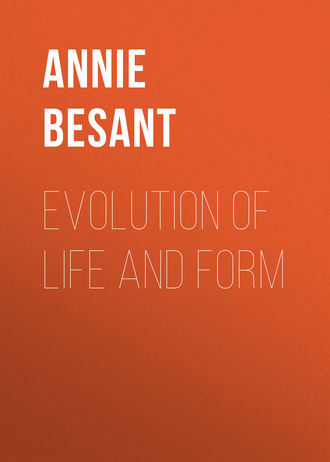 полная версия
полная версияEvolution of Life and Form

Evolution of Life and Form Four lectures delivered at the twenty-third anniversary meeting of the Theosophical Society at Adyar, Madras, 1898
[FIRST LECTURE.]
ANCIENT AND MODERN SCIENCE
My Brothers: – The subject on which I am to address you this morning, and the three mornings that follow, is one of considerable complexity and difficulty. I do not apologise to you for the difficulty of my theme. When we meet here in our Anniversary Meeting, we meet as students and not simply as superficial men and women of the world. We try to prepare ourselves, by study, for the exchange of thought which in these gatherings takes place, and although the subject is a difficult one, although it is not possible to make it clear and intelligible without the use of certain technical terms, yet, to the student technical terms – being precise – are really the easiest to understand, and inasmuch as, in a great majority at least, we are students, I who speak, and you who listen, we may be content to treat the subject in a somewhat formal and technical way. Roughly, my outline is this. I want to lay before you an intelligible conception of evolution, taking it on its two sides, that of the evolving life and that of the developing forms. I begin by laying before you a sketch of the methods of "Ancient and Modern Science," the direction in which each has worked, and is working, the ultimate union that, we hope, may take place between them. For what could more fully presage the good of the whole world, what could promise more happily for the relationship between the different races of humanity, than to draw together on the plane of mind the science of antiquity and of modern days, the science of the East and of the West, and, by wedding them to each other, draw together the nations that are now divided, and make objective that brotherhood of humanity of which we dream.
Dealing first with ancient and modern science in this broad and general way, and taking that as my subject for this morning, I shall pass on to-morrow to speak on the "Functions of the Gods," meaning by that phrase the activities of that invisible side of nature on which the whole of the visible depends. Whether we use here the name "Devas" to represent those developed spiritual intelligences, or whether with the child of Islâm, with the Hebrew or the Christian, we speak of the "Angels" and "Archangels," the name matters nothing; the conception is common to every faith of man. We shall study their functions in the universe, and try to understand how they act as the ministers of the Divine Will. Then we shall pass on to treat of that "Evolution of Life" which lies underneath the evolution of forms. Finally, we shall treat the "Evolution of Forms," and see how, in that evolution, is the promise of final perfection, how all is working to a perfect ending, how the best that we can dream of is less than the performance of God.
That is the outline of our work. Let us at once begin the first section of the subject – Ancient and Modern Science.
Now, in the olden times, in those times to which in this land our thought turns back most fondly with reverence and with pride, in those times, here, as in every other ancient land, Religion and Science were wedded together, and there was no discord between the intelligence and the spirit. It matters not whither you wander amid the ancient nations of the world: you may travel through the whole of Chaldea; you may study the remains of ancient Egypt; you may go through Persia and search amid her monuments; you may cross the Atlantic to America, and unbury the cities that were lost ere yet the Aztecs had made the mighty State which fell under the blows of the Spaniards; you may go into China and, in the vast recesses of that well-nigh unknown land, you may search for what has been left there from ancient days; or without going outside the limits of your own land, you may take the literature that is our pride, the mighty books written by the Ṛishis of the past; and everywhere antiquity speaks with a single tongue. Religion reveals the spirit, the spiritual truth which is one. Intelligence studies that truth in its manifold manifestations, and its work; science, studying the phenomena which are images of aspects of the Divine, is the handmaid, is the sister, of religion, and between them discord is unnatural and fatal to progress. That is the ancient view; but when we come to our own century a new phenomenon presents itself to our gaze – religion on the one side suspicious of science in its progress, science on the other hand apt to be proudly contemptuous of religious claims. How has the divorce arisen? Why this discord between two of the great helpers of human evolution? The reason is not far to seek. In the western world the science of the elder time, the science of antiquity, disappeared in the great flood of barbaric invasions, underneath the whirlpool caused by the ruins of the Roman Empire, and later on, underneath the wreckage of that same Empire with its new centre in Constantinople. The invasions of barbarians, both from the East and the North, sweeping over the European continent, brought ignorance in the wake of barbaric conquest. The result was that night came down upon knowledge and thick darkness enveloped the lands which were to be the nursery of a new civilisation. When the Sun of science again began to rise upon the Western world, it presented itself in a form which was alien, nay, which was more than alien, which was hostile to the dominant religion of the time. It came from the children of Islâm. It came from those who recognised Muhammed as their Prophet. From the Muslim schools of Arabia came the first teachers of modern science to Europe. True, they were really by their intellectual ancestry descended from the thought of Greece. They drew their inspiration from the school of Plato through the Neo-Platonists; they reproduced the ideas of Porphyry and Ptolemy, and of other Grecian and Egyptian thinkers, Neo-Platonic and even Gnostic. But they threw over it the garb of Islâm, they presented it in the form of Arabic thought. The result of this was that, as it made its way into Spain in the wake of the conquering Moors, as it came with those who drove out of the Southern Peninsula the rule of the Spanish Christian monarchy, so the first aspect of science to Christians was an aspect of hostility. It came as an invading enemy and not as an illuminant to all. Hence conflict arose; some who were within the limits of the mighty Church of Rome, touched by a longing for the new learning, stretched out their hands to take the gifts that science was bringing. These men were regarded with suspicion, nay, with more than suspicion, with hatred that broke out in bitter persecution. Who can read the history of Roger Bacon, the wondrous monk; who can picture Copernicus on his death-bed as his immortal work is brought to him ere yet his eyes are closed, he having shrunk from earlier publication, lest the stake should be his portion; who can stand in the Field of Flowers in Rome, and see there the statue erected where he was burned to death, who dying in one century, lives for all centuries to come – Giordano Bruno; who can listen to Galileo, as with faltering lips he denies the truth he knows and utters the falsehood that he knows not; who can follow these martyr-steps, led on by bitter memories of blood and fire, without understanding the reason for the hostility of science to religion, without confessing with shame and sorrow that that hostility was caused and was justified by the cruelties wreaked by religion on science, when science was young and feeble? Every one of us who stands upon the side of religion should recognise that we are reaping the bitter harvest of our own past errors, and that the law is just which brings upon us the difficulties and opposition we encounter in our modern days. For as science grew strong, she grew strong with the sword in her hands. She fought for every inch of the ground on which she stood, and only so far as she could guard herself was she safe from the flame or from the prison. Hence she searched for everything in nature that could serve as a weapon against the foe that attacked her. Hence she welcomed eagerly everything which seemed to show that materialism was the true philosophy of life. If we go back twenty-five years, to the time when I and some of you were young, we shall find that over western science there hung the shadow of materialism, and that stronger and stronger grew the scientific tendency to "see in matter the promise and the potency of every form of life." You remember those famous words of Professor Tyndall, no materialist in his thought and a religious man in his aspirations, but wellnigh driven by despair to claim fair field for science, and to fling back the claims of religion, because among them was included the right to gag, the refusal to allow thought to be honestly uttered by the thinker. But things are changing more and more; as religion has been growing more liberal and more rational, science is becoming less materialistic and less aggressive; and we shall see presently that the most modern of modern science – not quite the science that you get in your textbooks, for that is practically out-of-date in the rush of thought which comes from the West, but the science of the leaders of thought, the science of the first men in the scientific camp – is more and more approaching the domain where scientists will recognise religion as helper and not as enemy. In fact, speaking from the same chair from which Tyndall had uttered his famous phrase that "in matter he saw the promise and potency of every form of life," his successor, Sir William Crookes, a member of our own Theosophical Society, declared, reversing those words of his predecessor, that "In life I see the promise and potency of all forms of matter."
Such is the great change. Let us now examine in detail. The fundamental difference between ancient and modern science is that ancient science studies the world from the standpoint of life which is evolving, while modern science studies the world by observing the forms through which that life is manifesting. The first studies life, and sees in forms the expressions of life. The second studies forms, and tries, by the process of induction, to find out if there be an underlying principle by which the multiplicity of forms may be explained. The first works from above downwards, the second from below upwards, and in that very fact is the promise of a meeting place where the two will join hand in hand. But this fundamental difference carries with it very important results. If we are to study the world from the standpoint of forms, our study will be almost endless in its multiplicity. Think of a tree; the one trunk through which the life is pouring, innumerable leaves in which that life is ultimately expressed; it is an image of the tree of life, that great Ashvattha, the tree of which we have heard, whose roots are in the heavens and whose branches spread out over the earth. If we are to study it where its trunk is, the trunk of life, we have the unity of purpose and can trace why we have multiplicity of forms; but if we are to start at the parts where the leaves are growing, leaf by leaf we must examine, every difference of outline we must record, each little variety in shape we must carefully note and study. Science studies the leaves in modern days – the old science studied the life. There is the fundamental difference. There is also the reason of the difference of methods by which the study must be carried on. What is the method of modern science? The use of clear observation, keen judgment, power of placing like things together, and seeing the differences that divide the classes of the like from the classes of the unlike. But in order that this may be done, inasmuch as nature is infinite both in the vast and in the minute, man demands, to supplement his limited senses, instruments and apparatus of the most exquisite and delicate character; so that it has been even said that the progress of science is the progress of the exquisite nature of the apparatus which science uses, and scientific men will devise a more delicate balance, a more dainty way of adjustment, instrument after instrument, until perfection seems well-nigh to be reached; the modern man of science, to carry on his researches, demands a vast array of apparatus that he must use for his work, for according to the delicacy of his apparatus is the extent of his observation of the forms to which his attention is directed. But the man of science of the ancient type does not ask for instruments; he is not studying the evolution of forms; he has to study life, not form; and for such study he must evolve himself, the life that is within him, for only life can measure life, only life can respond to the vibrations of the living; his work is to unfold himself, to bring out of the depths of his own nature the divine powers that lie hidden therein, not in the senses but in the Self. His investigations can only be carried on by means of these powers, and only as he develops the divine within him will he be able to understand and measure the divine without him. Now this is only possible because, in essence, the natures of God and man are identical. This sounds a bold statement, but it is the fundamental truth of all religions. Need I quote to you the famous saying, "Thou art That"? Shall I take an equivalent phrase from the Hebrew Scripture, accepted by the whole Christian world: "God created man in His own image, in the image of God created He him"? The teaching is identical as all great truths are identical in the various religions; but what does it mean? God is manifest in His universe. Would you understand His work, you must develop the God within yourself, else will He for ever be veiled from your eyes. Not by the eyes of sense may you behold Him, not by the vision of intellect may you see that Form, invisible even to the intelligence. Only as the Self that is God is unfolded within you, will the Self that is the God without you manifest to you the full glory of His life. That is the ancient starting point. Thus what the man of old had to do, if indeed he were to be a man of science, was to become divine; he was to be a saint before he could be a sage. No man could be wise until he was pure, for how should impure eyes behold the Pure? There is the hall-mark of the man of science of the ancient days: he is developed within before he can be learned without. But from the modern man of science is not demanded this condition. He must indeed lead a life that is self-restrained, orderly, and fairly clean; were he to yield to the riot of the senses, his intelligence would become clouded. He must have keen power of observation, balanced strength of judgment, strong patience, unwearied industry, clear insight for differences and similarities. All these are demanded from him, if he is to be great, and these are among the noblest powers of intelligence. But all he asks of religion is to leave him alone. Of old, religion opened the gateway to science; now-a-days science asks nothing from religion save to stand aside. That is the difficulty in our way. We have to show that life cannot be understood until the student lives that which he seeks. That even the understanding of forms is very imperfect until the life expressed through them is recognised and partially understood. That fundamental difference of method then, will cover the whole field, and will enable us to comprehend the difference of the results.
Now let us try to understand more clearly why it was that the ancient man of science was taught that the first step to true knowledge, or wisdom, was the unfolding of the Self. What is life or consciousness – for the two terms are synonymous? It is the power to answer to vibrations, the power to respond – that is consciousness. Evolution is the unfolding of a continually increasing power to respond. The whole universe is full of the vibrations of Íshvara, of God. He sustains and moves the whole. Consciousness is the power in us to answer to those vibrations. All powers lie hidden within us as the oak tree lies hidden in the acorn. But it is in the process of evolution that the sapling slowly grows out of the seed. In Eternity, in the Now, all is existent, perfect; in Time only is there succession, the unfolding of one thing after another. In the changeless Point everything is present: Space is but the field for diverse sequences. Hence Time and Space are the basic illusions, and are yet the fundamental conditions of thinking. Keep, I pray you, that definition of consciousness in mind, for it will govern the remainder of our study.
The Self in man, being in the image of God, is triple as the Self, the Divine, is triple. I need not stop to argue this. You know it from that great literature which lies at the foundation of all Hindu Philosophy. Whether you speak in abstract terms and say with the Upanishad that Brahman is threefold, whether you speak of Him as Sat-chit-ânanda, or whether, instead of using philosophical, abstract terms, you say He is manifest as Íshvara in the Trimûrti as Mahâdeva, Vishnu and Brahmâ, it matters not. You may take the concrete form or the abstract, the fundamental idea is the same: that the Divine Self in manifestation is triple, and therefore in every great religion God is spoken of as a Trinity. If this were not so, the relationship between God and man would remain for ever unintelligible, for man shows a triplicity as he evolves. The human reflection of that triple Divine Self is the triple Self in man.
One by one are the Divine aspects unfolded as manifestation proceeds. The lowest, if I may dare to use such a term, is the aspect which is first brought into activity for the building of the universe. So also in man the intelligence awakens and becomes active, the lowest aspect of the human Self. That is the reflection of Brahmâ, of the Universal Mind, the creative energy from which all comes forth; and you may find in yourselves, as you evolve, that creative faculty of imagination which, working at present in subtle matter, will, when man is perfect, work in grosser matter as well; for the imaginative power in man is the reflection of the power that in God created the universe. Brahmâ meditated, and all forms came forth; and in the creative power of mind lies every possibility of form. So in man is later evolved the next aspect, that of A'nanda, where unity is recognised instead of diversity. Chit, in man, is the intelligence that knows, that separates and divides and analyses, and it has to do with the multiplicity of forms and with their inter-relations; A'nanda is the wisdom that realises the unity of all things, and that accomplishes union, thus finding the joy that lies at the very heart of life; last of all in human evolution, is developed the third and highest aspect of Deity, Self-Existence, the Unity that lies beyond union, and this can be developed in man only because man is one with the Eternal in his nature. By this evolution, in ages to come, through the countless kalpas that lie in front, Íshvara after Íshvara arises, each as the fruitage of a universe, to carry on still more mightily the will of the "One without a second," and to manifest something of that perfection to the whole of the then manifested nature. Such, very roughly, is the course of human evolution into divinity, and this is carried on by races succeeding one another; as we come to the higher Root-races of man, to those that we speak of as the Fifth, in which we are, the Sixth, that shall succeed us, and the Seventh that finishes this cycle of human evolution, we learn that the characteristic of each of these three Root-races is that each gradually develops that aspect of God which belongs to it in the due sequence of evolution. The Fifth is developing the aspect of Chit, Intelligence, the mind is being evolved, and all the progress of modern science, so marked in our own days, is but part of the fruitage of that evolution, of that growth of intelligence which looks on the outer world as not itself – as the Not-Self – and seeks to study and understand it. The characteristic attributes belonging to the evolution of the two following races are even now to be reached by special methods, by individuals who are willing to take the pains to make the required sacrifices. That which we know as Yoga is the method by which evolution is quickened in the individual, and all the powers of the Self, up to the threshold of divinity, may by it be brought into manifestation in the man of the present. That is why Yoga training was necessary for the ancient scientist; he must develop in himself the three aspects of God, if he were to understand them as manifested in the universe around him.
Now, at our own stage of evolution, it is specially the life of Brahmâ – or the Brahmâ aspect of God – with which the human mind is coming into touch, because the mind in man is the reflection of the universal mind in Kosmos. That life is the life that is the force in the atom, that vivifies every atom, nay, that brings the atom into existence, as we shall see, and remains during the whole of the growth of the universe as the fundamental life that keeps those atoms as active particles building up innumerable forms. Only as the life of Brahmâ, the aspect of Brahmâ, is developed in the human Self will man be able to study the workings of that life in the atomic forms that are filled by it; and it is very significant that some of the greatest problems of modern science are now turning on the nature of the atom, and that scientists are asking, what is it? Is it matter or force? Is it a particle or a vortex? Never will that question be answered with certainty until man has developed in himself the power to respond to the life that thrills in the atom, until, developing intelligence within himself to the fullest point, he is able to answer by that intelligence to the vibrations of the atomic life outside him. We have defined consciousness as the power to answer to vibrations, and if man is to measure life, if he is to know the underlying causes of phenomena, he must develop in himself the power to respond to that life outside him; and in the perfection of human intelligence – the reflection of the Brahmâ aspect of God – lies the only possibility of solution for this much debated problem in science. I said it was significant, for this problem belongs to the Fifth race, and the Western world is at present peopled largely by the fifth sub-race of the great Fifth. Thus it takes to the very highest point the concrete mind of man, that marvellous activity of the intellect, that swift and yet patient study, bringing about the achievements that modern science is performing. All these are a testimony of the truth of the ancient teaching that sub-race after sub-race arises, each one with its own work to do, and we should look on the work of each sub-division of humanity as good in itself: each should not be regarded as an isolated and hostile expression, but as part of the Divine manifestation, expressing that portion which it is destined to express.
Looking thus, then, on the problem of the life that exists in the atom, we find that in order to understand it, we must develop the pure intellect in man; but to understand the life that clothes itself in organic forms, to unravel the secrets which will explain to us why one is formed thus and another thus, the next great aspect of the Self must be developed within us – that of the all-pervading life of Vishnu, that sustains the world as the mighty supporter of everything, the basis, the foundation of the whole. There alone is unifying energy and there the root from which all divisions have arisen; only as we realise this aspect of unifying energy in the Self will the secrets of organised forms in nature unravel themselves before our eyes. This work is that of the Sixth Root-race, and those who would ante-date their evolution must develop Sixth-race powers in themselves by Yoga. Remains one mightier problem, subtlest and most difficult of all, that of the life of the human spirit, of man evolving into God. The mysteries of that life may only be understood when the human Self, which comes forth from the Father of all – from the mighty One who is sometimes the Destroyer, sometimes the Creator, but always the Regenerator, the name that includes them both, Mahâdeva, the mighty God who is Sat, Existence – has developed the aspect of Sat, of pure Existence, thus becoming the triple Unity, a Logos, an Íshvara. That is the work of the Seventh Root-race, and when that is accomplished, then only will the final problems of the human spirit lie open before our gaze.








